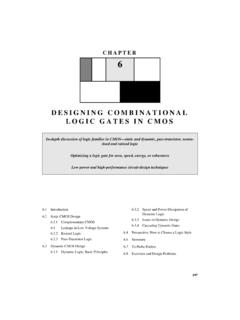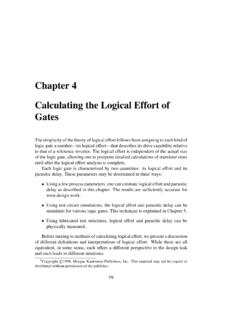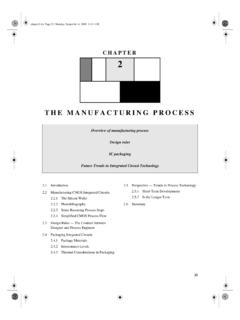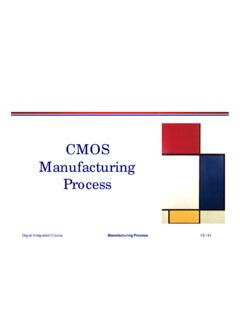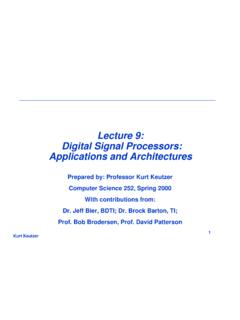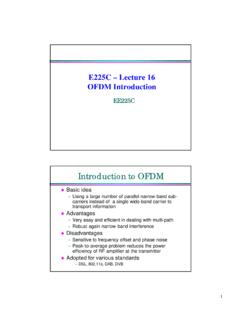Transcription of DESIGNING SEQUENTIAL LOGIC CIRCUITS
1 Page 270 Wednesday, November 22, 2000 8:41 AM. CHAPTER. 7. DESIGNING SEQUENTIAL LOGIC . CIRCUITS . Implementation techniques for flip-flops, latches, oscillators, pulse generators, and Schmitt triggers n Static versus dynamic realization n Choosing clocking strategies Introduction Dynamic Transmission-Gate Based Edge-triggred Registers Timing Metrics for SEQUENTIAL CIRCUITS C2 MOS Dynamic Register: A Clock Classification of Memory Elements Skew Insensitive Approach Static Latches and Registers True Single-Phase Clocked Register (TSPCR). Bistability Principle Pulse Registers Flip-Flops The C2 MOS Latch Based Latches NORA-CMOS A LOGIC Style for Based Edge Triggered Pipelined Structures Register True Single-Phase Clocked Register clock signals (TSPCR). Sense-Amplifier Based Registers Static Latches Pipelining: An approach to optimize SEQUENTIAL Dynamic Latches and Registers CIRCUITS 270.
2 Page 271 Wednesday, November 22, 2000 8:41 AM. Section 271. vs. Register-Based Pipelines A LOGIC Style for Pipelined Structures Non-Bistable SEQUENTIAL CIRCUITS Schmitt Trigger SEQUENTIAL CIRCUITS CIRCUITS Perspective: Choosing a Clocking Strategy Summary To Probe Further Exercises and Design Problems Page 272 Wednesday, November 22, 2000 8:41 AM. 272 DESIGNING SEQUENTIAL LOGIC CIRCUITS Chapter 7. Introduction combinational LOGIC CIRCUITS that were described earlier have the property that the output of a LOGIC block is only a function of the current input values, assuming that enough time has elapsed for the LOGIC gates to settle. Yet virtually all useful systems require storage of state information, leading to another class of CIRCUITS called SEQUENTIAL LOGIC CIRCUITS . In these CIRCUITS , the output not only depends upon the current values of the inputs, but also upon preceding input values.
3 In other words, a SEQUENTIAL circuit remembers some of the past history of the system it has memory. Figure shows a block diagram of a generic finite state machine (FSM) that con- sists of combinational LOGIC and registers that hold the system state. The system depicted here belongs to the class of synchronous SEQUENTIAL systems, in which all registers are under control of a single global clock. The outputs of the FSM are a function of the current Inputs and the Current State. The Next State is determined based on the Current State and the current Inputs and is fed to the inputs of registers. On the rising edge of the clock, the Next State bits are copied to the outputs of the registers (after some propagation delay), and a new cycle begins. The register then ignores changes in the input signals until the next rising edge.
4 In general, registers can be positive edge-triggered (where the input data is copied on the positive edge) or negative edge-triggered (where the input data is copied on the negative edge of the clock, as is indicated by a small circle at the clock input). Inputs Outputs combinational . LOGIC . Current State Next State Registers Q D. CLK. Figure Block diagram of a finite state machine using positive edge-triggered registers. This chapter discusses the CMOS implementation of the most important SEQUENTIAL building blocks. A variety of choices in SEQUENTIAL primitives and clocking methodologies exist; making the correct selection is getting increasingly important in modern digital cir- cuits, and can have a great impact on performance, power, and/or design complexity. Before embarking on a detailed discussion on the various design options, a revision of the design metrics, and a classification of the SEQUENTIAL elements is necessary.
5 Timing Metrics for SEQUENTIAL CIRCUITS There are three important timing parameters associated with a register as illustrated in Fig- ure The set-up time (tsu) is the time that the data inputs (D input) must be valid before the clock transition (this is, the 0 to 1 transition for a positive edge-triggered register). The hold time (thold) is the time the data input must remain valid after the clock edge. Assum- Page 273 Wednesday, November 22, 2000 8:41 AM. Section Classification of Memory Elements 273. CLK. t Register tsu thold D Q. D DATA CLK. STABLE t tc-q Figure Definition of set-up Q DATA time, hold time, and propagation STABLE t delay of a synchronous register. ing that the set-up and hold-times are met, the data at the D input is copied to the Q output after a worst-case propagation delay (with reference to the clock edge) denoted by tc-q.
6 Given the timing information for the registers and the combination LOGIC , some sys- tem-level timing constraints can be derived. Assume that the worst-case propagation delay of the LOGIC equals tplogic, while its minimum delay (also called the contamination delay) is tcd. The minimum clock period T, required for proper operation of the SEQUENTIAL circuit is given by T t c-q + t p log ic + t su ( ). The hold time of the register imposes an extra constraint for proper operation, t cdregister + t cdlogic t hold ( ). where tcdregister is the minimum propagation delay (or contamination delay) of the register. As seen from Eq. ( ), it is important to minimize the values of the timing parame- ters associated with the register, as these directly affect the rate at which a SEQUENTIAL cir- cuit can be clocked. In fact, modern high-performance systems are characterized by a very-low LOGIC depth, and the register propagation delay and set-up times account for a significant portion of the clock period.
7 For example, the DEC Alpha EV6 microprocessor [Gieseke97] has a maximum LOGIC depth of 12 gates, and the register overhead stands for approximately 15% of the clock period. In general, the requirement of Eq. ( ) is not hard to meet, although it becomes an issue when there is little or no LOGIC between registers, (or when the clocks at different registers are somewhat out of phase due to clock skew, as will be discussed in a later Chapter). Classification of Memory Elements Foreground versus Background Memory At a high level, memory is classified into background and foreground memory. Memory that is embedded into LOGIC is foreground memory, and is most often organized as individ- ual registers of register banks. Large amounts of centralized memory core are referred to as background memory. Background memory, discussed later in this book, achieves Page 274 Wednesday, November 22, 2000 8:41 AM.
8 274 DESIGNING SEQUENTIAL LOGIC CIRCUITS Chapter 7. higher area densities through efficient use of array structures and by trading off perfor- mance and robustness for size. In this chapter, we focus on foreground memories. Static versus Dynamic Memory Memories can be static or dynamic. Static memories preserve the state as long as the power is turned on. Static memories are built using positive feedback or regeneration, where the circuit topology consists of intentional connections between the output and the input of a combinational circuit . Static memories are most useful when the register won't be updated for extended periods of time. An example of such is configuration data, loaded at power-up time. This condition also holds for most processors that use conditional clock- ing ( , gated clocks) where the clock is turned off for unused modules.
9 In that case, there are no guarantees on how frequently the registers will be clocked, and static memories are needed to preserve the state information. Memory based on positive feedback fall under the class of elements called multivibrator CIRCUITS . The bistable element, is its most popu- lar representative, but other elements such as monostable and astable CIRCUITS are also fre- quently used. Dynamic memories store state for a short period of time on the order of millisec- onds. They are based on the principle of temporary charge storage on parasitic capacitors associated with MOS devices. As with dynamic LOGIC discussed earlier, the capacitors have to be refreshed periodically to annihilate charge leakage. Dynamic memories tend to simpler, resulting in significantly higher performance and lower power dissipation.
10 They are most useful in datapath CIRCUITS that require high performance levels and are periodi- cally clocked. It is possible to use dynamic circuitry even when CIRCUITS are conditionally clocked, if the state can be discarded when a module goes into idle mode. Latches vs. Registers A latch is an essential component in the construction of an edge-triggered register. It is level-sensitive circuit that passes the D input to the Q output when the clock signal is high. This latch is said to be in transparent mode. When the clock is low, the input data sampled on the falling edge of the clock is held stable at the output for the entire phase, and the latch is in hold mode. The inputs must be stable for a short period around the falling edge of the clock to meet set-up and hold requirements. A latch operating under the above con- ditions is a positive latch.
